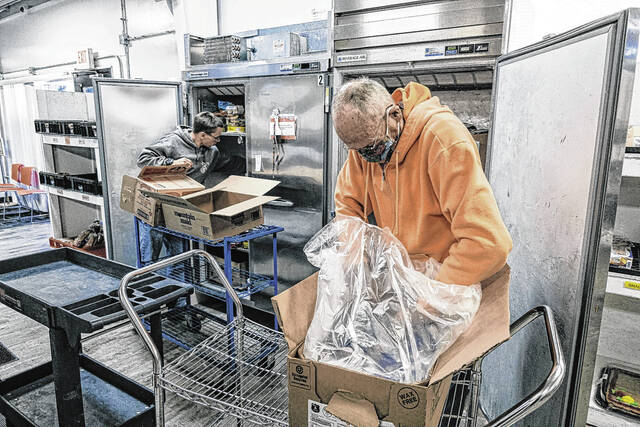
Republic file photo Andrew Lykins, left, and Mark Bolander stock frozen and refrigerated food goods at the Love Chapel Food Pantry in Columbus.
Love Chapel food pantry is planning to embark on the largest expansion in the organization’s history over the coming years in an effort to increase access to food in Bartholomew County.
The plan, approved by the organization’s 33-member board, includes efforts to increase evening hours at its food pantry, expand services in rural areas of the county, increase food deliveries and offer services geared at the county’s growing Latinx population, said Love Chapel Executive Director Kelly Daugherty.
To reach the goals in the plan, the county’s largest food pantry will need to greatly increase the number of volunteers it has and hire around five additional paid staff, including a Spanish-speaking employee and a staff member focused on recruiting volunteers, Daugherty said.
Love Chapel, known as the Ecumenical Assembly of Bartholomew County Churches, has been operating for more than five decades, according to its website.
“We are really excited about it,” Daugherty said of the plans. “It’s going to be a challenge though, don’t get me wrong. But it can really expand the effect that we have and the benefit we have to folks.”
‘Ambitious’ plans
Love Chapel now operates 9 a.m. to noon on weekdays and offers, among other services, a mobile food pantry each month in Bartholomew County, rotating through different areas of the county.
Within the next several years, the food pantry hopes to have a weekly evening food pantry at its location at 292 Center St. and set aside one day each week for delivering food to people who can’t come in person for pickup.
Love Chapel also plans to divide the county into four areas and hold a monthly food pantry in each area every month, Daugherty said.
Starting in January, Love Chapel will start offering a monthly food distribution in German Township — an area Daugherty said is one of the most underserved areas in Bartholomew County — aimed at the Latinx population.
About 19% of German Township residents are of Hispanic origin, according to the 2020 U.S. Census.
“Some of the most need that we have in our county is in the rural areas,” Daugherty said. “I think people flock to those areas because the cheaper housing is outside of the city limits, and there are folks that are struggling to get by.”
Increased food insecurity
The plans come as projections from the nation’s largest food bank network suggest that the economic upheaval from the pandemic may have undone a decade of progress on food security in Bartholomew County.
Love Chapel, as well as other local food pantries, have seen a staggering increased in demand for food at various times during the pandemic.
In August 2020, Love Chapel reported the highest one-month increase in demand for food in the organization’s history, serving about 4,150 people that month, the equivalent of around 1 in 20 Bartholomew County residents, Daugherty said.
The following month, 550 families lined up in cars to receive food at Columbus Municipal Airport in the latest in a series of monthly food distributions organized by Indianapolis-based Gleaners Food Bank of Indiana. At one point, the line of cars stretched about a half-mile.
This past September, food banks around the U.S. reported giving away far more canned, packaged and fresh provisions than they did before the virus outbreak tossed millions of people out of work, forcing many to seek something to eat for the first time, The Associated Press reported. Many of those now back at work are still struggling, paying back rent or trying to rebuild savings.
It took about a decade for food insecurity levels to return to pre-Great Recession levels, according to the U.S. Department of Agriculture, which describes food insecurity as a lack of access to enough food for an active, healthy life.
Data from Feeding America, a national network of more than 200 food banks, is projecting that food insecurity in Bartholomew County increased last year to the highest rate in at least 10 years.
Last year, nearly an additional 2,400 Bartholomew County residents — including about an additional 1,000 children — were food insecure compared to 2019, according to the projections.
Overall, 15% of local residents were projected to have experienced food insecurity last year — including 1 in 5 children — up from 12.1% in 2019 and the highest rate since at least 2010.
While Feeding America is projecting that food insecurity will improve this year in Bartholomew County, the local rate will likely be the highest seen over the past decade except for last year.
This year, 13.3% of local residents are expected to be food insecure, including roughly 1 in 6 children, according to the projections.
Despite the improvement, an additional 1,000 residents and 360 additional children in the county are projected be food insecure this year compared to the year before the pandemic.
Before 2020, the highest food insecurity rate in Bartholomew County over the past decade on record was in 2010, when 13% of residents were food insecure.
Record-setting year
Love Chapel, for its part, is on pace to distribute 1.5 million pounds of food this year, which would be an all-time record, Daugherty said.
That is nearly five times the weight of all the copper and framework in the Statue of Liberty, according to the national monument’s website.
In July, Love Chapel received a 36,000-pound donation of food from a storehouse in Salt Lake City — the largest-ever single-source donation and enough food to feed local families for about two weeks.
Last year, Love Chapel gave out about 1.38 million pounds of food, which was a record at the time, Daugherty said.
“Last year was a record,” Daugherty said. “This will be an even bigger record. We’ve never given out that much food in one year.”
“I’m just excited to see what the next three to five years bring,” Daugherty said. “I think it’s got the potential to be great.”




